MANAGEMENT ACCOUNTING Management Accounting Name of the Student
VerifiedAdded on 2023/04/21
|12
|3017
|371
AI Summary
Contribute Materials
Your contribution can guide someone’s learning journey. Share your
documents today.
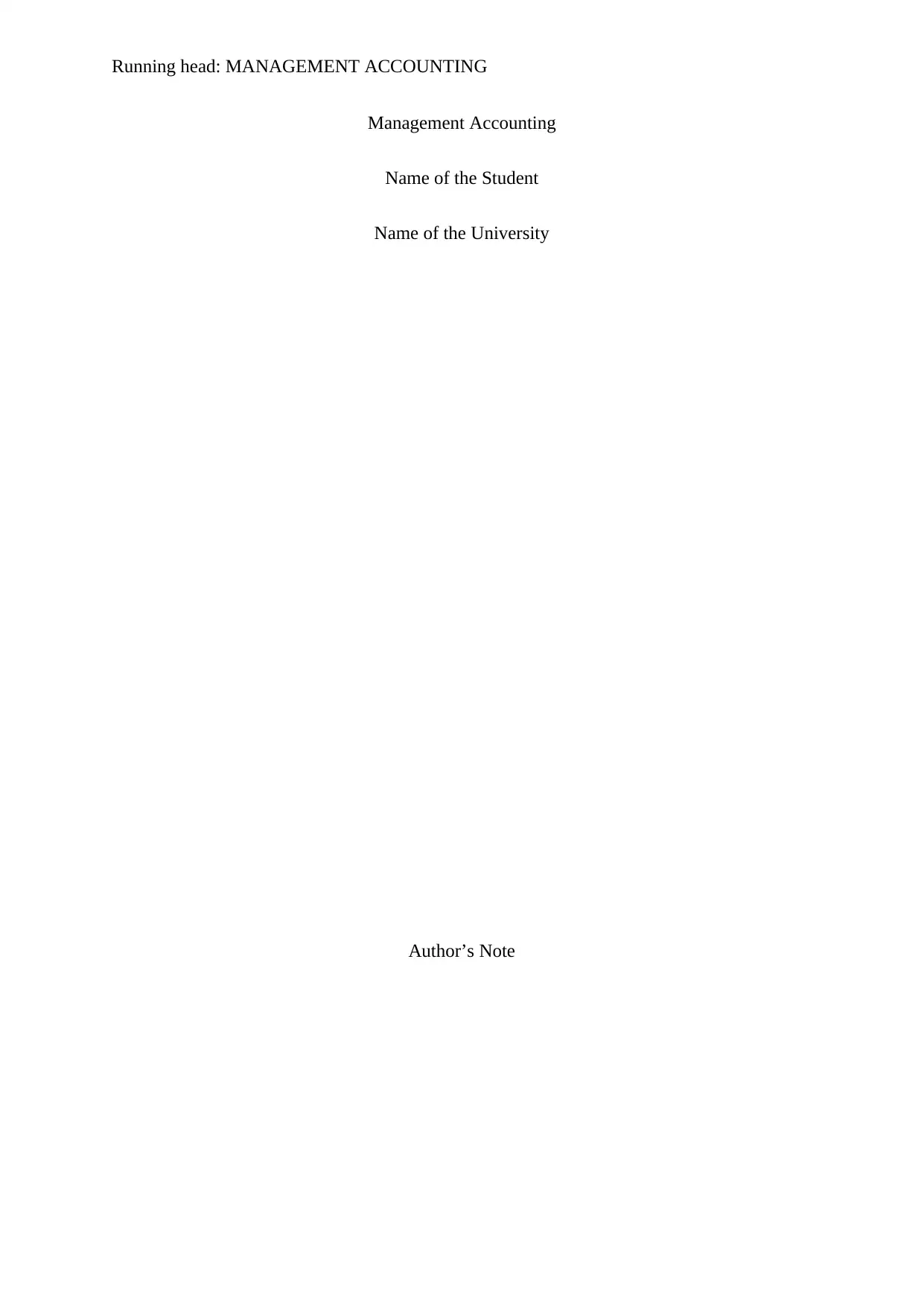
Running head: MANAGEMENT ACCOUNTING
Management Accounting
Name of the Student
Name of the University
Author’s Note
Management Accounting
Name of the Student
Name of the University
Author’s Note
Secure Best Marks with AI Grader
Need help grading? Try our AI Grader for instant feedback on your assignments.
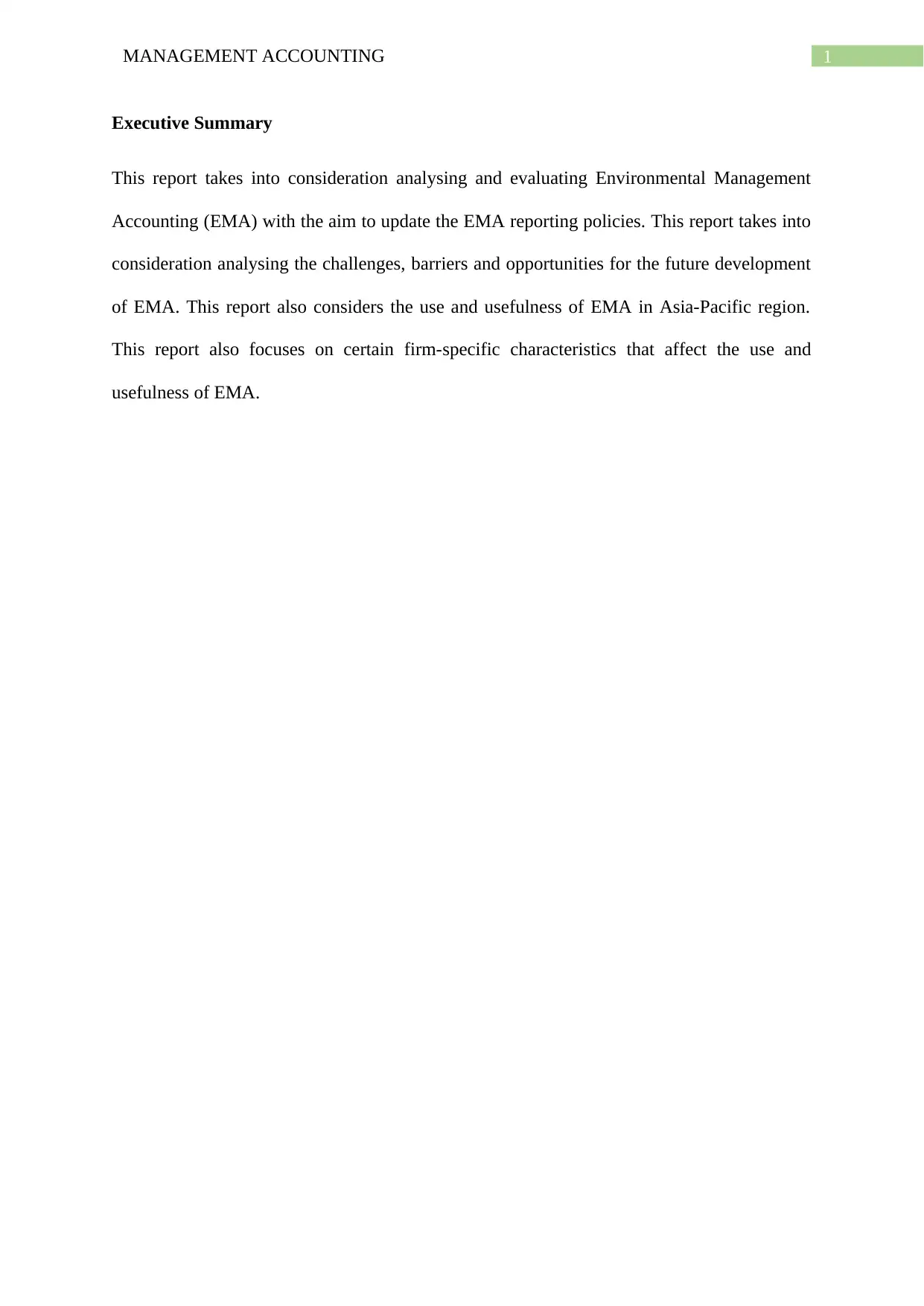
1MANAGEMENT ACCOUNTING
Executive Summary
This report takes into consideration analysing and evaluating Environmental Management
Accounting (EMA) with the aim to update the EMA reporting policies. This report takes into
consideration analysing the challenges, barriers and opportunities for the future development
of EMA. This report also considers the use and usefulness of EMA in Asia-Pacific region.
This report also focuses on certain firm-specific characteristics that affect the use and
usefulness of EMA.
Executive Summary
This report takes into consideration analysing and evaluating Environmental Management
Accounting (EMA) with the aim to update the EMA reporting policies. This report takes into
consideration analysing the challenges, barriers and opportunities for the future development
of EMA. This report also considers the use and usefulness of EMA in Asia-Pacific region.
This report also focuses on certain firm-specific characteristics that affect the use and
usefulness of EMA.
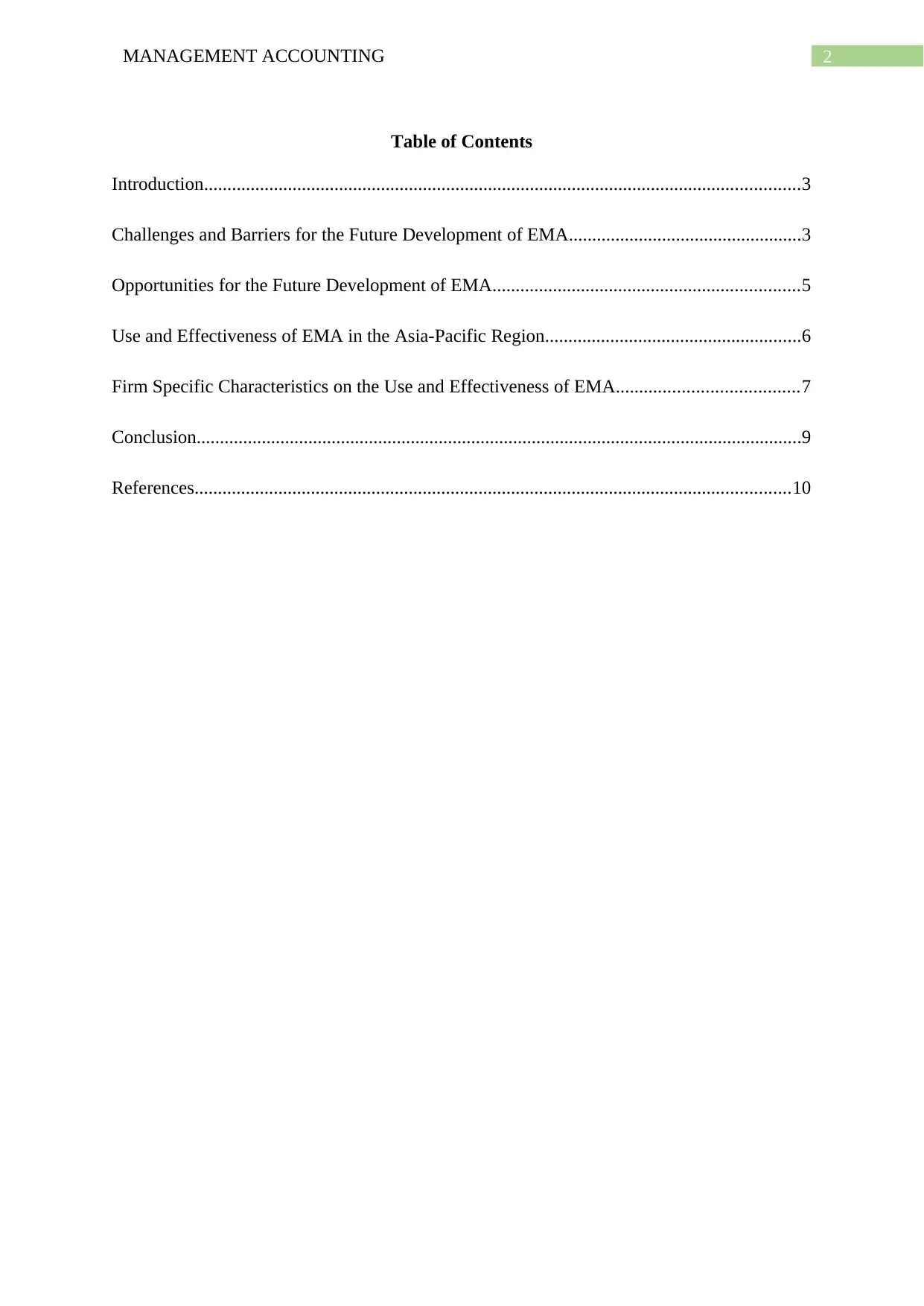
2MANAGEMENT ACCOUNTING
Table of Contents
Introduction................................................................................................................................3
Challenges and Barriers for the Future Development of EMA..................................................3
Opportunities for the Future Development of EMA..................................................................5
Use and Effectiveness of EMA in the Asia-Pacific Region.......................................................6
Firm Specific Characteristics on the Use and Effectiveness of EMA.......................................7
Conclusion..................................................................................................................................9
References................................................................................................................................10
Table of Contents
Introduction................................................................................................................................3
Challenges and Barriers for the Future Development of EMA..................................................3
Opportunities for the Future Development of EMA..................................................................5
Use and Effectiveness of EMA in the Asia-Pacific Region.......................................................6
Firm Specific Characteristics on the Use and Effectiveness of EMA.......................................7
Conclusion..................................................................................................................................9
References................................................................................................................................10

3MANAGEMENT ACCOUNTING
Introduction
In the recent years, Environmental Management Accounting (EMA) is considered as
an essential part as EMA can be described as the effective management of environmental as
well as economic performance of the firm through developing and implementing proper
environment-related accounting system and practice (Christ and Burritt 2013). Since there
has been major increase in the significance of environmental management and its part to
manage and reduce environmental impacts, the development of an effective EMA system has
started to gain greater attention and interests of the firms as this system can become majorly
helpful for the managements of the firms to attain their organizational goals and objectives
(Gunarathne and Lee 2015). At the same time, the companies are facing certain types of
challenges and barriers at the time to develop and implement the EMA. The main aim of this
report is the analysis and evaluation of various aspects of EMA such as challenges, barriers,
development opportunities, use, usefulness and others.
Challenges and Barriers for the Future Development of EMA
In spite of the presence of many benefits of EMA, business organizations have to face
certain challenges in the form of barriers for the future development of EMA. They are
institutional barriers, management barriers, financial barriers, information barrier and cultural
barrier; these are discussed below.
Institutional Barrier: Most of the companies face this barrier as a prime barrier while for the
development and implementation of EMA. Institutional barrier in EMA is the lack of
institutional pressure, lack of the power of shareholders and the lack of the power of other
key stakeholders. At the same time, the companies also face the pressure from the
government in the development and implementation of EMA. Hence, the managements of the
Introduction
In the recent years, Environmental Management Accounting (EMA) is considered as
an essential part as EMA can be described as the effective management of environmental as
well as economic performance of the firm through developing and implementing proper
environment-related accounting system and practice (Christ and Burritt 2013). Since there
has been major increase in the significance of environmental management and its part to
manage and reduce environmental impacts, the development of an effective EMA system has
started to gain greater attention and interests of the firms as this system can become majorly
helpful for the managements of the firms to attain their organizational goals and objectives
(Gunarathne and Lee 2015). At the same time, the companies are facing certain types of
challenges and barriers at the time to develop and implement the EMA. The main aim of this
report is the analysis and evaluation of various aspects of EMA such as challenges, barriers,
development opportunities, use, usefulness and others.
Challenges and Barriers for the Future Development of EMA
In spite of the presence of many benefits of EMA, business organizations have to face
certain challenges in the form of barriers for the future development of EMA. They are
institutional barriers, management barriers, financial barriers, information barrier and cultural
barrier; these are discussed below.
Institutional Barrier: Most of the companies face this barrier as a prime barrier while for the
development and implementation of EMA. Institutional barrier in EMA is the lack of
institutional pressure, lack of the power of shareholders and the lack of the power of other
key stakeholders. At the same time, the companies also face the pressure from the
government in the development and implementation of EMA. Hence, the managements of the
Secure Best Marks with AI Grader
Need help grading? Try our AI Grader for instant feedback on your assignments.
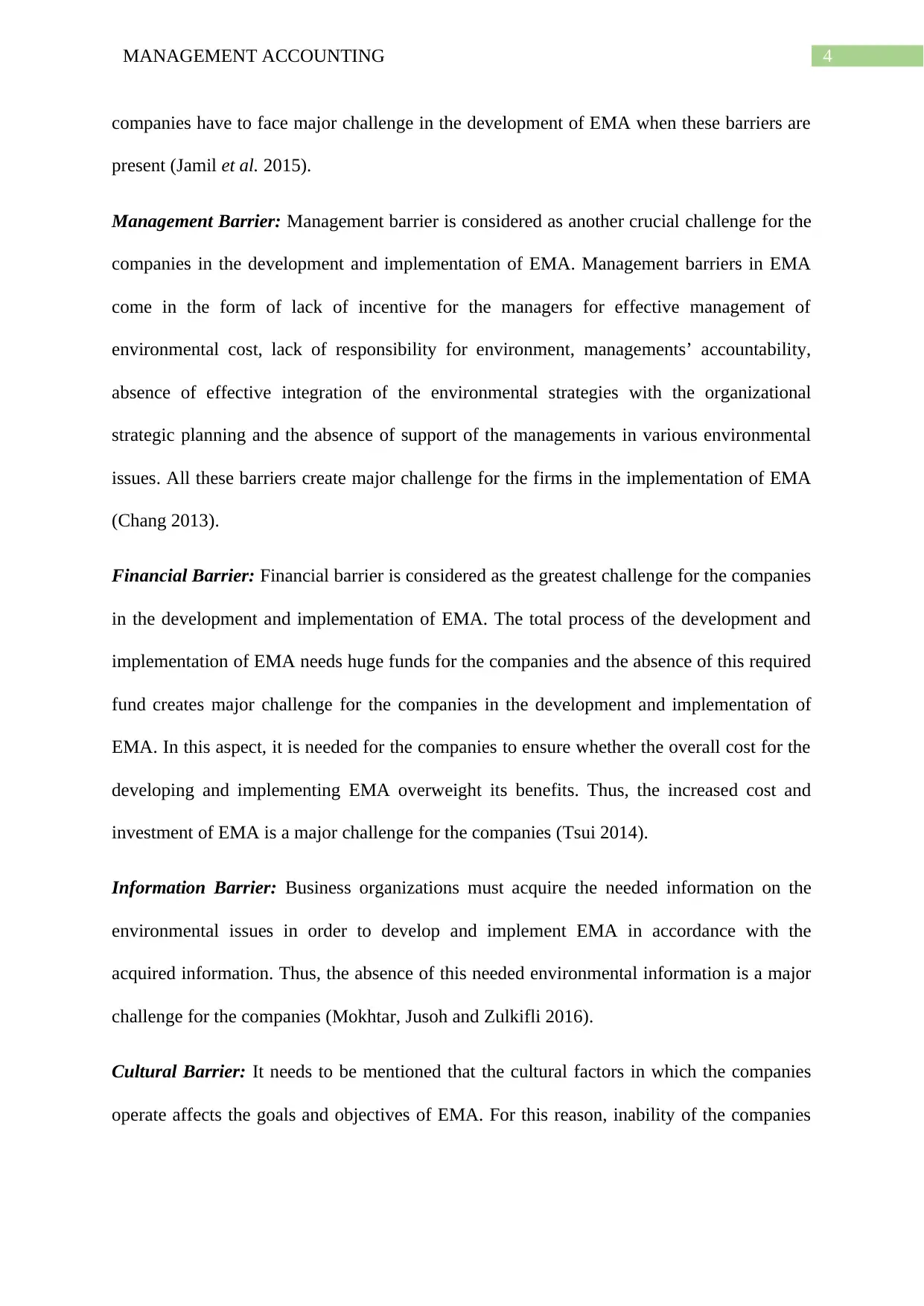
4MANAGEMENT ACCOUNTING
companies have to face major challenge in the development of EMA when these barriers are
present (Jamil et al. 2015).
Management Barrier: Management barrier is considered as another crucial challenge for the
companies in the development and implementation of EMA. Management barriers in EMA
come in the form of lack of incentive for the managers for effective management of
environmental cost, lack of responsibility for environment, managements’ accountability,
absence of effective integration of the environmental strategies with the organizational
strategic planning and the absence of support of the managements in various environmental
issues. All these barriers create major challenge for the firms in the implementation of EMA
(Chang 2013).
Financial Barrier: Financial barrier is considered as the greatest challenge for the companies
in the development and implementation of EMA. The total process of the development and
implementation of EMA needs huge funds for the companies and the absence of this required
fund creates major challenge for the companies in the development and implementation of
EMA. In this aspect, it is needed for the companies to ensure whether the overall cost for the
developing and implementing EMA overweight its benefits. Thus, the increased cost and
investment of EMA is a major challenge for the companies (Tsui 2014).
Information Barrier: Business organizations must acquire the needed information on the
environmental issues in order to develop and implement EMA in accordance with the
acquired information. Thus, the absence of this needed environmental information is a major
challenge for the companies (Mokhtar, Jusoh and Zulkifli 2016).
Cultural Barrier: It needs to be mentioned that the cultural factors in which the companies
operate affects the goals and objectives of EMA. For this reason, inability of the companies
companies have to face major challenge in the development of EMA when these barriers are
present (Jamil et al. 2015).
Management Barrier: Management barrier is considered as another crucial challenge for the
companies in the development and implementation of EMA. Management barriers in EMA
come in the form of lack of incentive for the managers for effective management of
environmental cost, lack of responsibility for environment, managements’ accountability,
absence of effective integration of the environmental strategies with the organizational
strategic planning and the absence of support of the managements in various environmental
issues. All these barriers create major challenge for the firms in the implementation of EMA
(Chang 2013).
Financial Barrier: Financial barrier is considered as the greatest challenge for the companies
in the development and implementation of EMA. The total process of the development and
implementation of EMA needs huge funds for the companies and the absence of this required
fund creates major challenge for the companies in the development and implementation of
EMA. In this aspect, it is needed for the companies to ensure whether the overall cost for the
developing and implementing EMA overweight its benefits. Thus, the increased cost and
investment of EMA is a major challenge for the companies (Tsui 2014).
Information Barrier: Business organizations must acquire the needed information on the
environmental issues in order to develop and implement EMA in accordance with the
acquired information. Thus, the absence of this needed environmental information is a major
challenge for the companies (Mokhtar, Jusoh and Zulkifli 2016).
Cultural Barrier: It needs to be mentioned that the cultural factors in which the companies
operate affects the goals and objectives of EMA. For this reason, inability of the companies
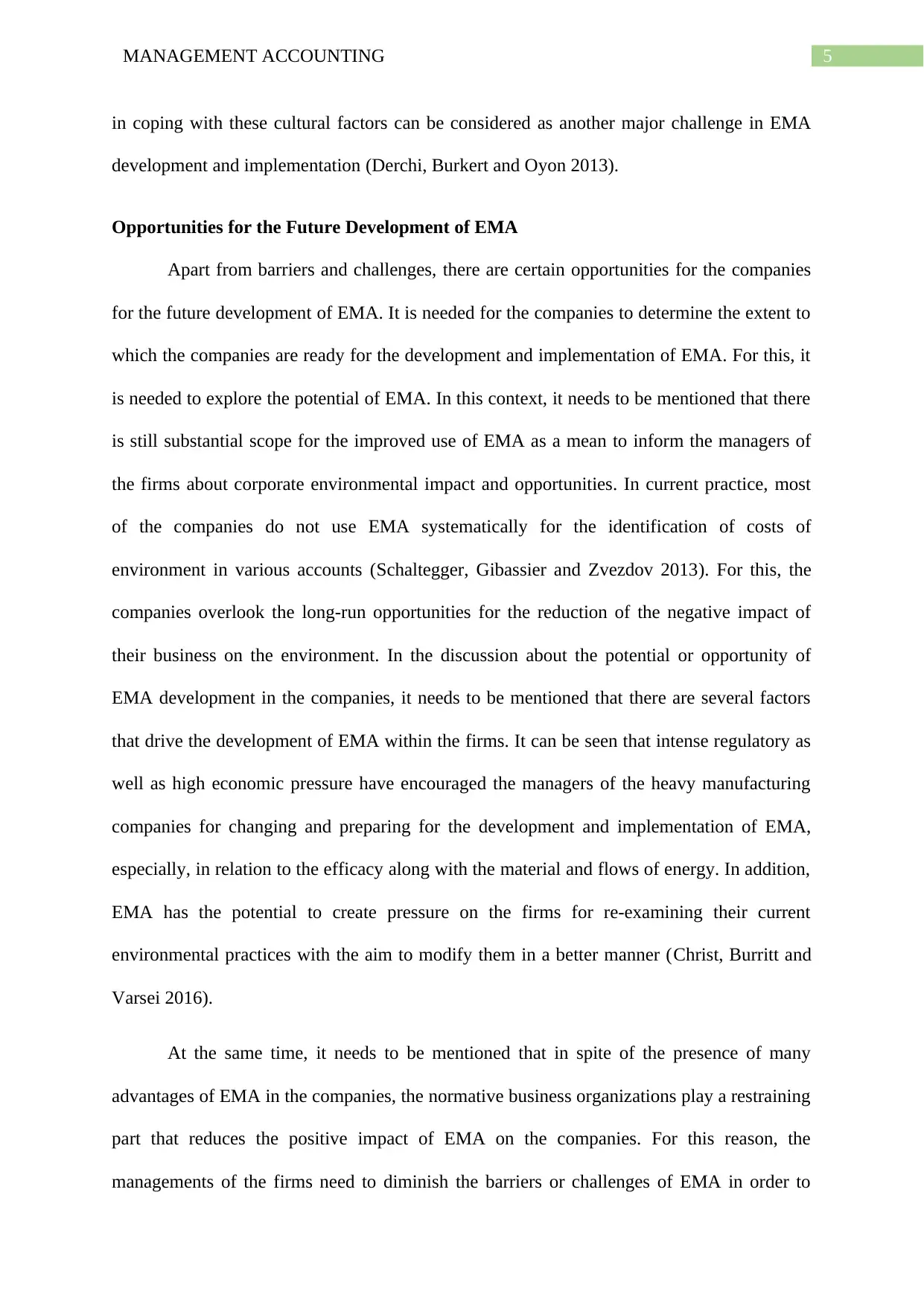
5MANAGEMENT ACCOUNTING
in coping with these cultural factors can be considered as another major challenge in EMA
development and implementation (Derchi, Burkert and Oyon 2013).
Opportunities for the Future Development of EMA
Apart from barriers and challenges, there are certain opportunities for the companies
for the future development of EMA. It is needed for the companies to determine the extent to
which the companies are ready for the development and implementation of EMA. For this, it
is needed to explore the potential of EMA. In this context, it needs to be mentioned that there
is still substantial scope for the improved use of EMA as a mean to inform the managers of
the firms about corporate environmental impact and opportunities. In current practice, most
of the companies do not use EMA systematically for the identification of costs of
environment in various accounts (Schaltegger, Gibassier and Zvezdov 2013). For this, the
companies overlook the long-run opportunities for the reduction of the negative impact of
their business on the environment. In the discussion about the potential or opportunity of
EMA development in the companies, it needs to be mentioned that there are several factors
that drive the development of EMA within the firms. It can be seen that intense regulatory as
well as high economic pressure have encouraged the managers of the heavy manufacturing
companies for changing and preparing for the development and implementation of EMA,
especially, in relation to the efficacy along with the material and flows of energy. In addition,
EMA has the potential to create pressure on the firms for re-examining their current
environmental practices with the aim to modify them in a better manner (Christ, Burritt and
Varsei 2016).
At the same time, it needs to be mentioned that in spite of the presence of many
advantages of EMA in the companies, the normative business organizations play a restraining
part that reduces the positive impact of EMA on the companies. For this reason, the
managements of the firms need to diminish the barriers or challenges of EMA in order to
in coping with these cultural factors can be considered as another major challenge in EMA
development and implementation (Derchi, Burkert and Oyon 2013).
Opportunities for the Future Development of EMA
Apart from barriers and challenges, there are certain opportunities for the companies
for the future development of EMA. It is needed for the companies to determine the extent to
which the companies are ready for the development and implementation of EMA. For this, it
is needed to explore the potential of EMA. In this context, it needs to be mentioned that there
is still substantial scope for the improved use of EMA as a mean to inform the managers of
the firms about corporate environmental impact and opportunities. In current practice, most
of the companies do not use EMA systematically for the identification of costs of
environment in various accounts (Schaltegger, Gibassier and Zvezdov 2013). For this, the
companies overlook the long-run opportunities for the reduction of the negative impact of
their business on the environment. In the discussion about the potential or opportunity of
EMA development in the companies, it needs to be mentioned that there are several factors
that drive the development of EMA within the firms. It can be seen that intense regulatory as
well as high economic pressure have encouraged the managers of the heavy manufacturing
companies for changing and preparing for the development and implementation of EMA,
especially, in relation to the efficacy along with the material and flows of energy. In addition,
EMA has the potential to create pressure on the firms for re-examining their current
environmental practices with the aim to modify them in a better manner (Christ, Burritt and
Varsei 2016).
At the same time, it needs to be mentioned that in spite of the presence of many
advantages of EMA in the companies, the normative business organizations play a restraining
part that reduces the positive impact of EMA on the companies. For this reason, the
managements of the firms need to diminish the barriers or challenges of EMA in order to
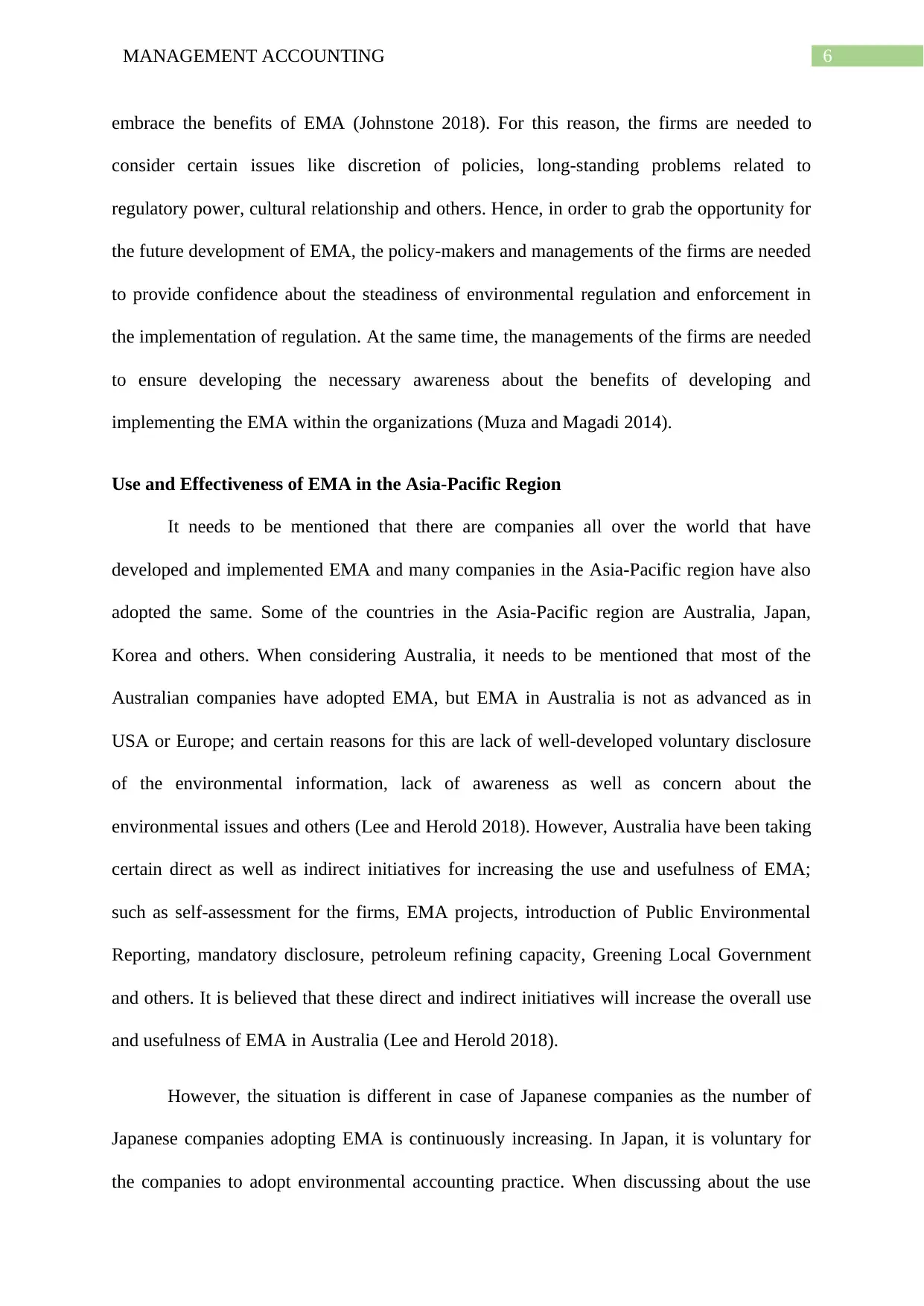
6MANAGEMENT ACCOUNTING
embrace the benefits of EMA (Johnstone 2018). For this reason, the firms are needed to
consider certain issues like discretion of policies, long-standing problems related to
regulatory power, cultural relationship and others. Hence, in order to grab the opportunity for
the future development of EMA, the policy-makers and managements of the firms are needed
to provide confidence about the steadiness of environmental regulation and enforcement in
the implementation of regulation. At the same time, the managements of the firms are needed
to ensure developing the necessary awareness about the benefits of developing and
implementing the EMA within the organizations (Muza and Magadi 2014).
Use and Effectiveness of EMA in the Asia-Pacific Region
It needs to be mentioned that there are companies all over the world that have
developed and implemented EMA and many companies in the Asia-Pacific region have also
adopted the same. Some of the countries in the Asia-Pacific region are Australia, Japan,
Korea and others. When considering Australia, it needs to be mentioned that most of the
Australian companies have adopted EMA, but EMA in Australia is not as advanced as in
USA or Europe; and certain reasons for this are lack of well-developed voluntary disclosure
of the environmental information, lack of awareness as well as concern about the
environmental issues and others (Lee and Herold 2018). However, Australia have been taking
certain direct as well as indirect initiatives for increasing the use and usefulness of EMA;
such as self-assessment for the firms, EMA projects, introduction of Public Environmental
Reporting, mandatory disclosure, petroleum refining capacity, Greening Local Government
and others. It is believed that these direct and indirect initiatives will increase the overall use
and usefulness of EMA in Australia (Lee and Herold 2018).
However, the situation is different in case of Japanese companies as the number of
Japanese companies adopting EMA is continuously increasing. In Japan, it is voluntary for
the companies to adopt environmental accounting practice. When discussing about the use
embrace the benefits of EMA (Johnstone 2018). For this reason, the firms are needed to
consider certain issues like discretion of policies, long-standing problems related to
regulatory power, cultural relationship and others. Hence, in order to grab the opportunity for
the future development of EMA, the policy-makers and managements of the firms are needed
to provide confidence about the steadiness of environmental regulation and enforcement in
the implementation of regulation. At the same time, the managements of the firms are needed
to ensure developing the necessary awareness about the benefits of developing and
implementing the EMA within the organizations (Muza and Magadi 2014).
Use and Effectiveness of EMA in the Asia-Pacific Region
It needs to be mentioned that there are companies all over the world that have
developed and implemented EMA and many companies in the Asia-Pacific region have also
adopted the same. Some of the countries in the Asia-Pacific region are Australia, Japan,
Korea and others. When considering Australia, it needs to be mentioned that most of the
Australian companies have adopted EMA, but EMA in Australia is not as advanced as in
USA or Europe; and certain reasons for this are lack of well-developed voluntary disclosure
of the environmental information, lack of awareness as well as concern about the
environmental issues and others (Lee and Herold 2018). However, Australia have been taking
certain direct as well as indirect initiatives for increasing the use and usefulness of EMA;
such as self-assessment for the firms, EMA projects, introduction of Public Environmental
Reporting, mandatory disclosure, petroleum refining capacity, Greening Local Government
and others. It is believed that these direct and indirect initiatives will increase the overall use
and usefulness of EMA in Australia (Lee and Herold 2018).
However, the situation is different in case of Japanese companies as the number of
Japanese companies adopting EMA is continuously increasing. In Japan, it is voluntary for
the companies to adopt environmental accounting practice. When discussing about the use
Paraphrase This Document
Need a fresh take? Get an instant paraphrase of this document with our AI Paraphraser
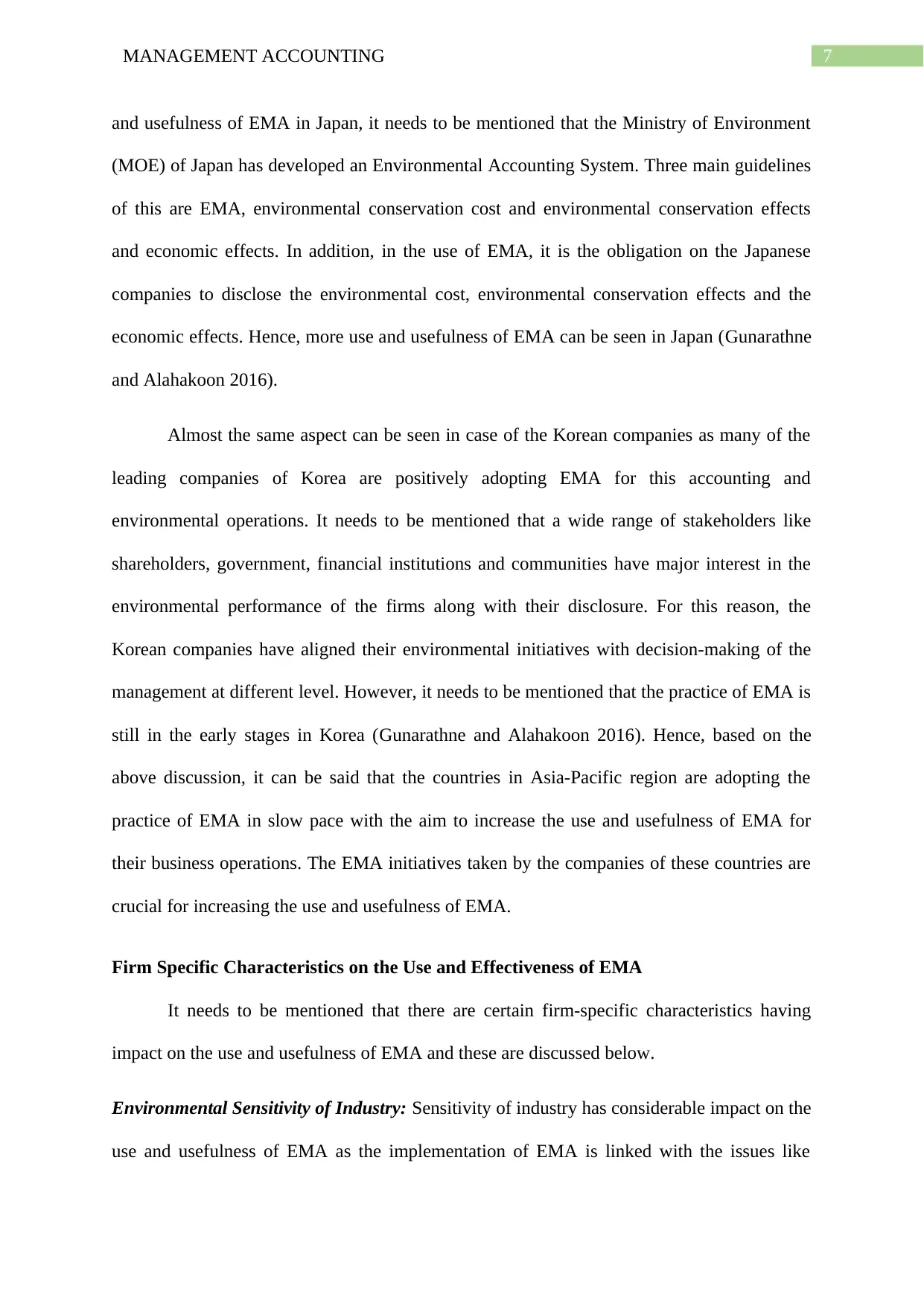
7MANAGEMENT ACCOUNTING
and usefulness of EMA in Japan, it needs to be mentioned that the Ministry of Environment
(MOE) of Japan has developed an Environmental Accounting System. Three main guidelines
of this are EMA, environmental conservation cost and environmental conservation effects
and economic effects. In addition, in the use of EMA, it is the obligation on the Japanese
companies to disclose the environmental cost, environmental conservation effects and the
economic effects. Hence, more use and usefulness of EMA can be seen in Japan (Gunarathne
and Alahakoon 2016).
Almost the same aspect can be seen in case of the Korean companies as many of the
leading companies of Korea are positively adopting EMA for this accounting and
environmental operations. It needs to be mentioned that a wide range of stakeholders like
shareholders, government, financial institutions and communities have major interest in the
environmental performance of the firms along with their disclosure. For this reason, the
Korean companies have aligned their environmental initiatives with decision-making of the
management at different level. However, it needs to be mentioned that the practice of EMA is
still in the early stages in Korea (Gunarathne and Alahakoon 2016). Hence, based on the
above discussion, it can be said that the countries in Asia-Pacific region are adopting the
practice of EMA in slow pace with the aim to increase the use and usefulness of EMA for
their business operations. The EMA initiatives taken by the companies of these countries are
crucial for increasing the use and usefulness of EMA.
Firm Specific Characteristics on the Use and Effectiveness of EMA
It needs to be mentioned that there are certain firm-specific characteristics having
impact on the use and usefulness of EMA and these are discussed below.
Environmental Sensitivity of Industry: Sensitivity of industry has considerable impact on the
use and usefulness of EMA as the implementation of EMA is linked with the issues like
and usefulness of EMA in Japan, it needs to be mentioned that the Ministry of Environment
(MOE) of Japan has developed an Environmental Accounting System. Three main guidelines
of this are EMA, environmental conservation cost and environmental conservation effects
and economic effects. In addition, in the use of EMA, it is the obligation on the Japanese
companies to disclose the environmental cost, environmental conservation effects and the
economic effects. Hence, more use and usefulness of EMA can be seen in Japan (Gunarathne
and Alahakoon 2016).
Almost the same aspect can be seen in case of the Korean companies as many of the
leading companies of Korea are positively adopting EMA for this accounting and
environmental operations. It needs to be mentioned that a wide range of stakeholders like
shareholders, government, financial institutions and communities have major interest in the
environmental performance of the firms along with their disclosure. For this reason, the
Korean companies have aligned their environmental initiatives with decision-making of the
management at different level. However, it needs to be mentioned that the practice of EMA is
still in the early stages in Korea (Gunarathne and Alahakoon 2016). Hence, based on the
above discussion, it can be said that the countries in Asia-Pacific region are adopting the
practice of EMA in slow pace with the aim to increase the use and usefulness of EMA for
their business operations. The EMA initiatives taken by the companies of these countries are
crucial for increasing the use and usefulness of EMA.
Firm Specific Characteristics on the Use and Effectiveness of EMA
It needs to be mentioned that there are certain firm-specific characteristics having
impact on the use and usefulness of EMA and these are discussed below.
Environmental Sensitivity of Industry: Sensitivity of industry has considerable impact on the
use and usefulness of EMA as the implementation of EMA is linked with the issues like
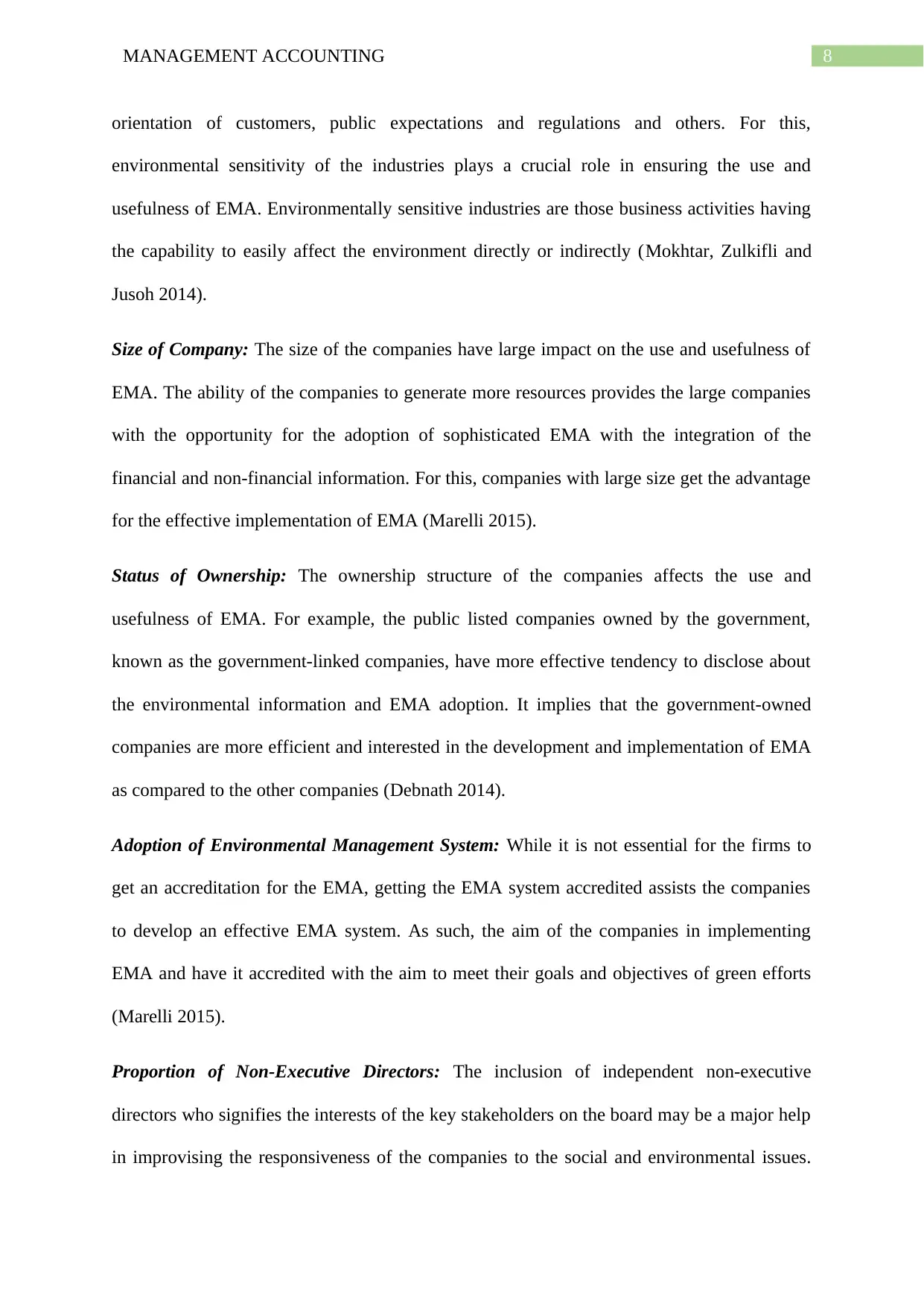
8MANAGEMENT ACCOUNTING
orientation of customers, public expectations and regulations and others. For this,
environmental sensitivity of the industries plays a crucial role in ensuring the use and
usefulness of EMA. Environmentally sensitive industries are those business activities having
the capability to easily affect the environment directly or indirectly (Mokhtar, Zulkifli and
Jusoh 2014).
Size of Company: The size of the companies have large impact on the use and usefulness of
EMA. The ability of the companies to generate more resources provides the large companies
with the opportunity for the adoption of sophisticated EMA with the integration of the
financial and non-financial information. For this, companies with large size get the advantage
for the effective implementation of EMA (Marelli 2015).
Status of Ownership: The ownership structure of the companies affects the use and
usefulness of EMA. For example, the public listed companies owned by the government,
known as the government-linked companies, have more effective tendency to disclose about
the environmental information and EMA adoption. It implies that the government-owned
companies are more efficient and interested in the development and implementation of EMA
as compared to the other companies (Debnath 2014).
Adoption of Environmental Management System: While it is not essential for the firms to
get an accreditation for the EMA, getting the EMA system accredited assists the companies
to develop an effective EMA system. As such, the aim of the companies in implementing
EMA and have it accredited with the aim to meet their goals and objectives of green efforts
(Marelli 2015).
Proportion of Non-Executive Directors: The inclusion of independent non-executive
directors who signifies the interests of the key stakeholders on the board may be a major help
in improvising the responsiveness of the companies to the social and environmental issues.
orientation of customers, public expectations and regulations and others. For this,
environmental sensitivity of the industries plays a crucial role in ensuring the use and
usefulness of EMA. Environmentally sensitive industries are those business activities having
the capability to easily affect the environment directly or indirectly (Mokhtar, Zulkifli and
Jusoh 2014).
Size of Company: The size of the companies have large impact on the use and usefulness of
EMA. The ability of the companies to generate more resources provides the large companies
with the opportunity for the adoption of sophisticated EMA with the integration of the
financial and non-financial information. For this, companies with large size get the advantage
for the effective implementation of EMA (Marelli 2015).
Status of Ownership: The ownership structure of the companies affects the use and
usefulness of EMA. For example, the public listed companies owned by the government,
known as the government-linked companies, have more effective tendency to disclose about
the environmental information and EMA adoption. It implies that the government-owned
companies are more efficient and interested in the development and implementation of EMA
as compared to the other companies (Debnath 2014).
Adoption of Environmental Management System: While it is not essential for the firms to
get an accreditation for the EMA, getting the EMA system accredited assists the companies
to develop an effective EMA system. As such, the aim of the companies in implementing
EMA and have it accredited with the aim to meet their goals and objectives of green efforts
(Marelli 2015).
Proportion of Non-Executive Directors: The inclusion of independent non-executive
directors who signifies the interests of the key stakeholders on the board may be a major help
in improvising the responsiveness of the companies to the social and environmental issues.
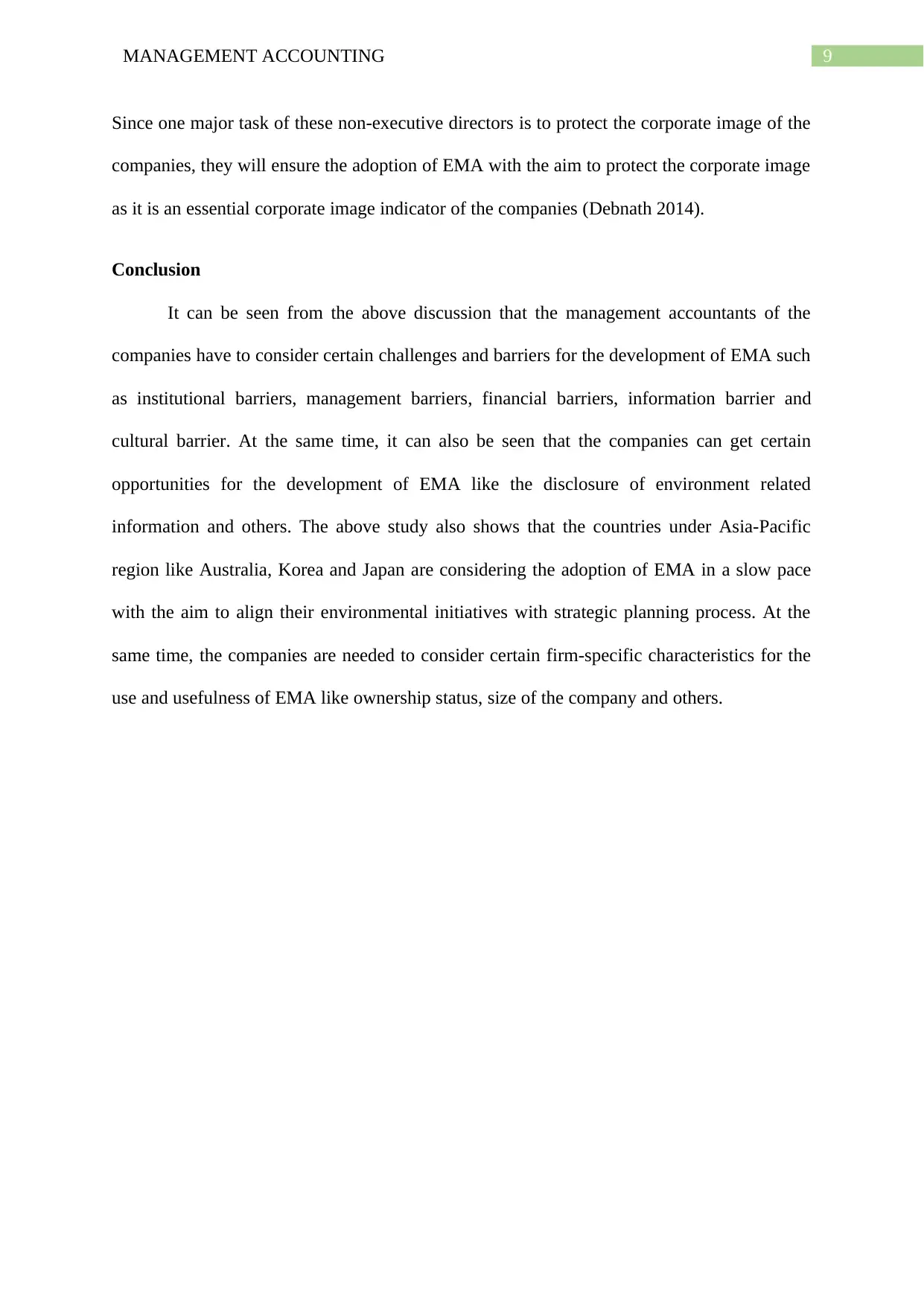
9MANAGEMENT ACCOUNTING
Since one major task of these non-executive directors is to protect the corporate image of the
companies, they will ensure the adoption of EMA with the aim to protect the corporate image
as it is an essential corporate image indicator of the companies (Debnath 2014).
Conclusion
It can be seen from the above discussion that the management accountants of the
companies have to consider certain challenges and barriers for the development of EMA such
as institutional barriers, management barriers, financial barriers, information barrier and
cultural barrier. At the same time, it can also be seen that the companies can get certain
opportunities for the development of EMA like the disclosure of environment related
information and others. The above study also shows that the countries under Asia-Pacific
region like Australia, Korea and Japan are considering the adoption of EMA in a slow pace
with the aim to align their environmental initiatives with strategic planning process. At the
same time, the companies are needed to consider certain firm-specific characteristics for the
use and usefulness of EMA like ownership status, size of the company and others.
Since one major task of these non-executive directors is to protect the corporate image of the
companies, they will ensure the adoption of EMA with the aim to protect the corporate image
as it is an essential corporate image indicator of the companies (Debnath 2014).
Conclusion
It can be seen from the above discussion that the management accountants of the
companies have to consider certain challenges and barriers for the development of EMA such
as institutional barriers, management barriers, financial barriers, information barrier and
cultural barrier. At the same time, it can also be seen that the companies can get certain
opportunities for the development of EMA like the disclosure of environment related
information and others. The above study also shows that the countries under Asia-Pacific
region like Australia, Korea and Japan are considering the adoption of EMA in a slow pace
with the aim to align their environmental initiatives with strategic planning process. At the
same time, the companies are needed to consider certain firm-specific characteristics for the
use and usefulness of EMA like ownership status, size of the company and others.
Secure Best Marks with AI Grader
Need help grading? Try our AI Grader for instant feedback on your assignments.

10MANAGEMENT ACCOUNTING
References
Chang, H.C., 2013. Environmental management accounting in the Taiwanese higher
education sector: issues and opportunities. International Journal of Sustainability in Higher
Education, 14(2), pp.133-145.
Christ, K.L. and Burritt, R.L., 2013. Environmental management accounting: the significance
of contingent variables for adoption. Journal of Cleaner Production, 41, pp.163-173.
Christ, K.L., Burritt, R. and Varsei, M., 2016. Towards environmental management
accounting for trade-offs. Sustainability Accounting, Management and Policy Journal, 7(3),
pp.428-448.
Debnath, S., 2014. Expanding environmental management accounting: an experimental
construct to integrate material wastes and emission flows. International Journal of Business
Information Systems 1, 16(2), pp.119-133.
Derchi, G.B., Burkert, M. and Oyon, D., 2013. Environmental management accounting
systems: A review of the evidence and propositions for future research. In Accounting and
Control for Sustainability (pp. 197-229). Emerald Group Publishing Limited.
Gunarathne, A.N. and Alahakoon, Y., 2016. Environmental management accounting
practices and their diffusion: the Sri Lankan experience.
Gunarathne, N. and Lee, K.H., 2015. Environmental Management Accounting (EMA) for
environmental management and organizational change: An eco-control approach. Journal of
Accounting & Organizational Change, 11(3), pp.362-383.
Jamil, C.Z.M., Mohamed, R., Muhammad, F. and Ali, A., 2015. Environmental management
accounting practices in small medium manufacturing firms. Procedia-Social and Behavioral
Sciences, 172, pp.619-626.
References
Chang, H.C., 2013. Environmental management accounting in the Taiwanese higher
education sector: issues and opportunities. International Journal of Sustainability in Higher
Education, 14(2), pp.133-145.
Christ, K.L. and Burritt, R.L., 2013. Environmental management accounting: the significance
of contingent variables for adoption. Journal of Cleaner Production, 41, pp.163-173.
Christ, K.L., Burritt, R. and Varsei, M., 2016. Towards environmental management
accounting for trade-offs. Sustainability Accounting, Management and Policy Journal, 7(3),
pp.428-448.
Debnath, S., 2014. Expanding environmental management accounting: an experimental
construct to integrate material wastes and emission flows. International Journal of Business
Information Systems 1, 16(2), pp.119-133.
Derchi, G.B., Burkert, M. and Oyon, D., 2013. Environmental management accounting
systems: A review of the evidence and propositions for future research. In Accounting and
Control for Sustainability (pp. 197-229). Emerald Group Publishing Limited.
Gunarathne, A.N. and Alahakoon, Y., 2016. Environmental management accounting
practices and their diffusion: the Sri Lankan experience.
Gunarathne, N. and Lee, K.H., 2015. Environmental Management Accounting (EMA) for
environmental management and organizational change: An eco-control approach. Journal of
Accounting & Organizational Change, 11(3), pp.362-383.
Jamil, C.Z.M., Mohamed, R., Muhammad, F. and Ali, A., 2015. Environmental management
accounting practices in small medium manufacturing firms. Procedia-Social and Behavioral
Sciences, 172, pp.619-626.
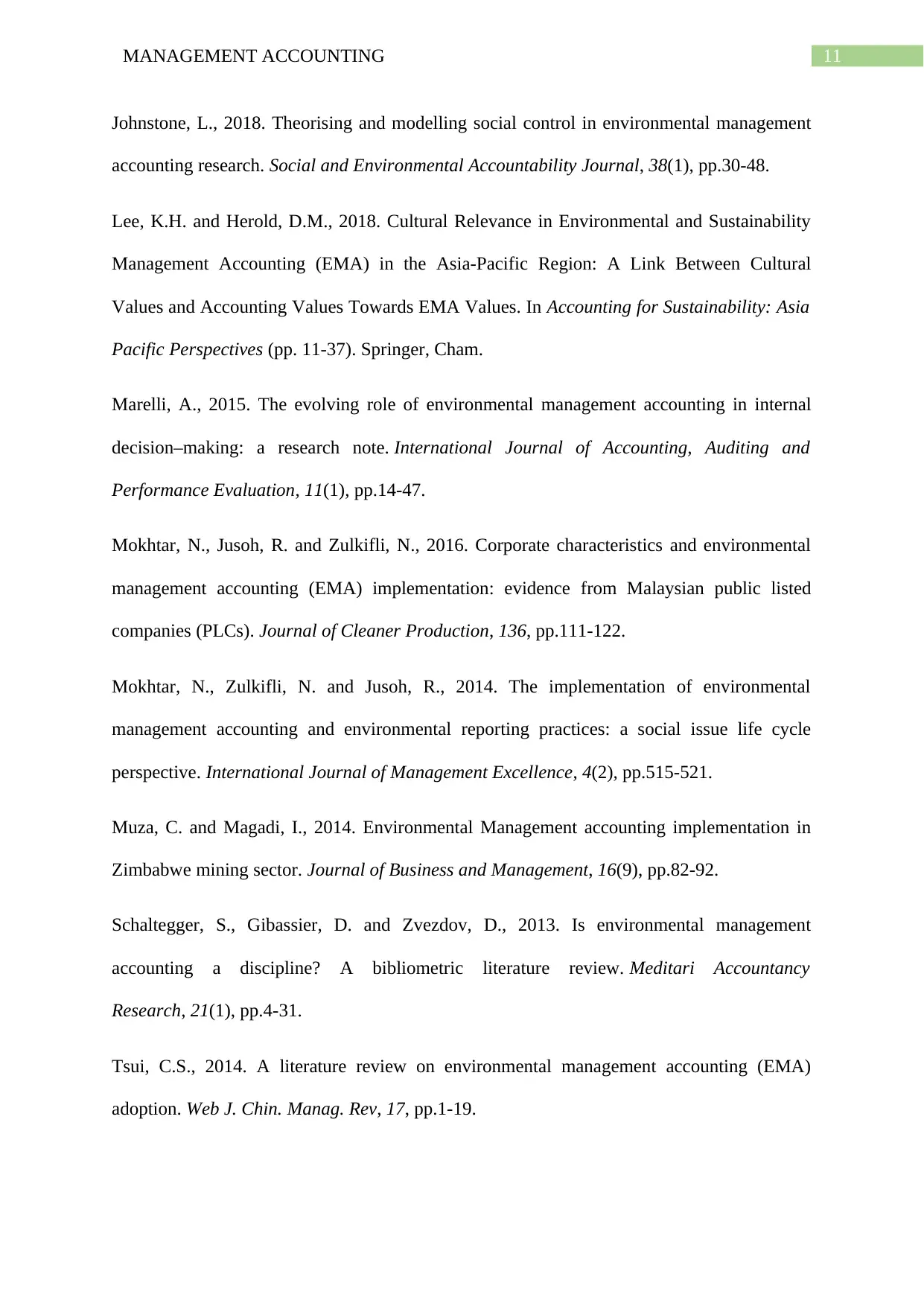
11MANAGEMENT ACCOUNTING
Johnstone, L., 2018. Theorising and modelling social control in environmental management
accounting research. Social and Environmental Accountability Journal, 38(1), pp.30-48.
Lee, K.H. and Herold, D.M., 2018. Cultural Relevance in Environmental and Sustainability
Management Accounting (EMA) in the Asia-Pacific Region: A Link Between Cultural
Values and Accounting Values Towards EMA Values. In Accounting for Sustainability: Asia
Pacific Perspectives (pp. 11-37). Springer, Cham.
Marelli, A., 2015. The evolving role of environmental management accounting in internal
decision–making: a research note. International Journal of Accounting, Auditing and
Performance Evaluation, 11(1), pp.14-47.
Mokhtar, N., Jusoh, R. and Zulkifli, N., 2016. Corporate characteristics and environmental
management accounting (EMA) implementation: evidence from Malaysian public listed
companies (PLCs). Journal of Cleaner Production, 136, pp.111-122.
Mokhtar, N., Zulkifli, N. and Jusoh, R., 2014. The implementation of environmental
management accounting and environmental reporting practices: a social issue life cycle
perspective. International Journal of Management Excellence, 4(2), pp.515-521.
Muza, C. and Magadi, I., 2014. Environmental Management accounting implementation in
Zimbabwe mining sector. Journal of Business and Management, 16(9), pp.82-92.
Schaltegger, S., Gibassier, D. and Zvezdov, D., 2013. Is environmental management
accounting a discipline? A bibliometric literature review. Meditari Accountancy
Research, 21(1), pp.4-31.
Tsui, C.S., 2014. A literature review on environmental management accounting (EMA)
adoption. Web J. Chin. Manag. Rev, 17, pp.1-19.
Johnstone, L., 2018. Theorising and modelling social control in environmental management
accounting research. Social and Environmental Accountability Journal, 38(1), pp.30-48.
Lee, K.H. and Herold, D.M., 2018. Cultural Relevance in Environmental and Sustainability
Management Accounting (EMA) in the Asia-Pacific Region: A Link Between Cultural
Values and Accounting Values Towards EMA Values. In Accounting for Sustainability: Asia
Pacific Perspectives (pp. 11-37). Springer, Cham.
Marelli, A., 2015. The evolving role of environmental management accounting in internal
decision–making: a research note. International Journal of Accounting, Auditing and
Performance Evaluation, 11(1), pp.14-47.
Mokhtar, N., Jusoh, R. and Zulkifli, N., 2016. Corporate characteristics and environmental
management accounting (EMA) implementation: evidence from Malaysian public listed
companies (PLCs). Journal of Cleaner Production, 136, pp.111-122.
Mokhtar, N., Zulkifli, N. and Jusoh, R., 2014. The implementation of environmental
management accounting and environmental reporting practices: a social issue life cycle
perspective. International Journal of Management Excellence, 4(2), pp.515-521.
Muza, C. and Magadi, I., 2014. Environmental Management accounting implementation in
Zimbabwe mining sector. Journal of Business and Management, 16(9), pp.82-92.
Schaltegger, S., Gibassier, D. and Zvezdov, D., 2013. Is environmental management
accounting a discipline? A bibliometric literature review. Meditari Accountancy
Research, 21(1), pp.4-31.
Tsui, C.S., 2014. A literature review on environmental management accounting (EMA)
adoption. Web J. Chin. Manag. Rev, 17, pp.1-19.
1 out of 12
Related Documents
Your All-in-One AI-Powered Toolkit for Academic Success.
+13062052269
info@desklib.com
Available 24*7 on WhatsApp / Email
![[object Object]](/_next/static/media/star-bottom.7253800d.svg)
Unlock your academic potential
© 2024 | Zucol Services PVT LTD | All rights reserved.





